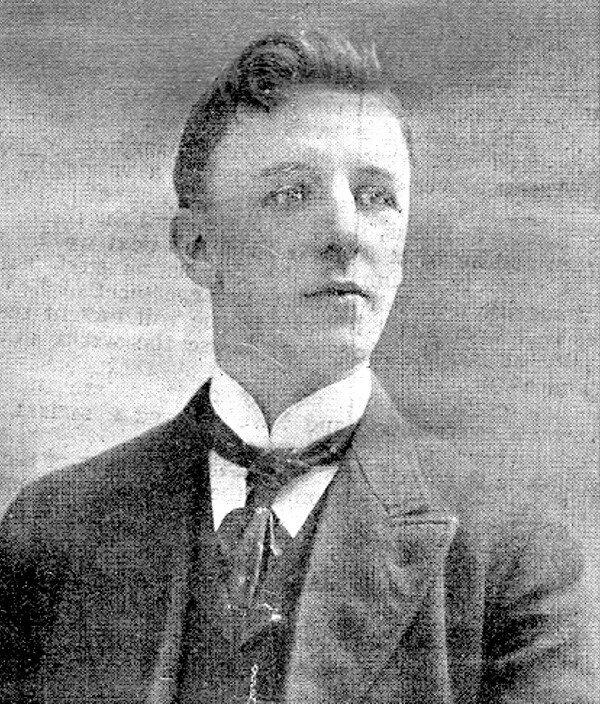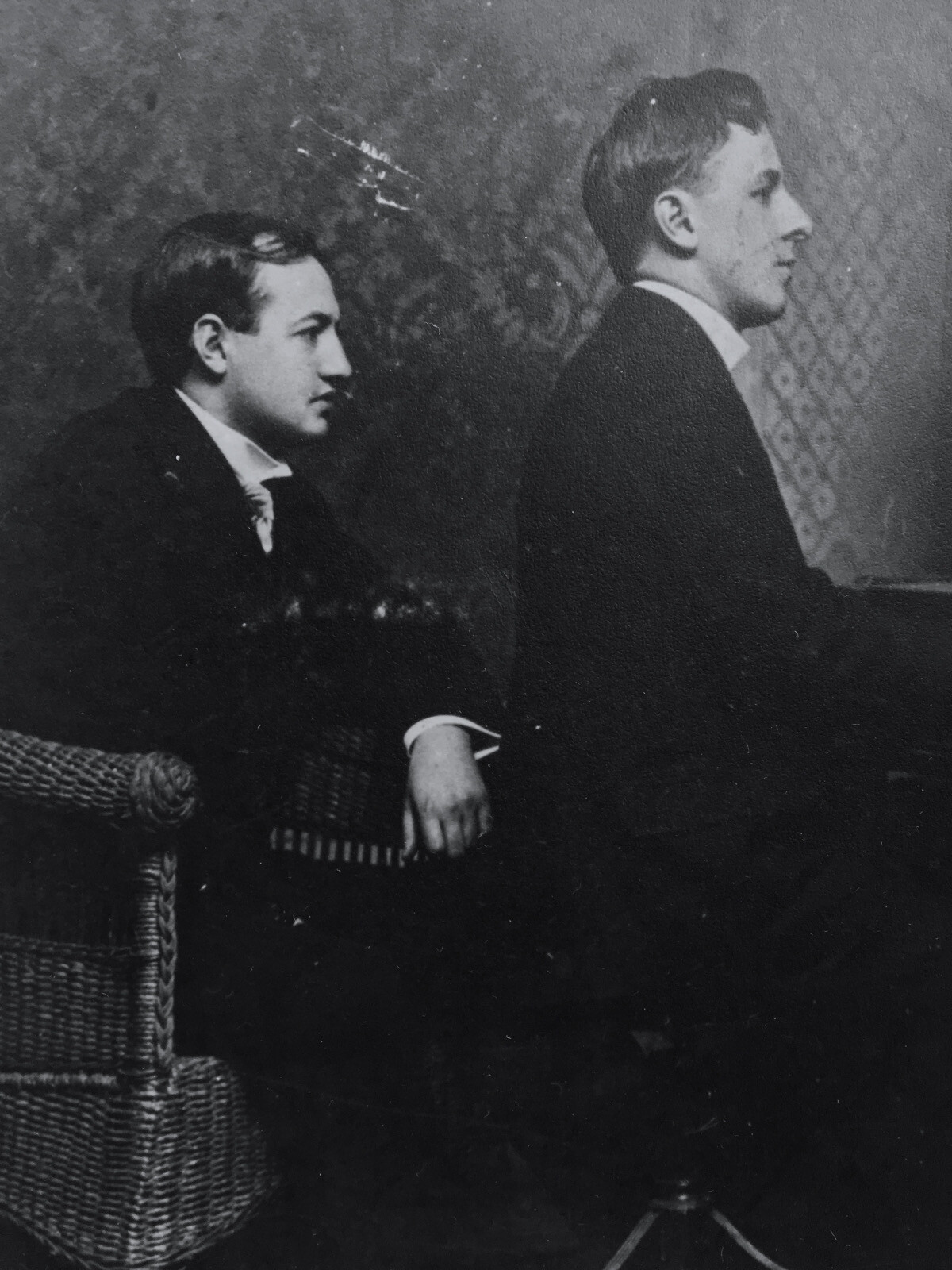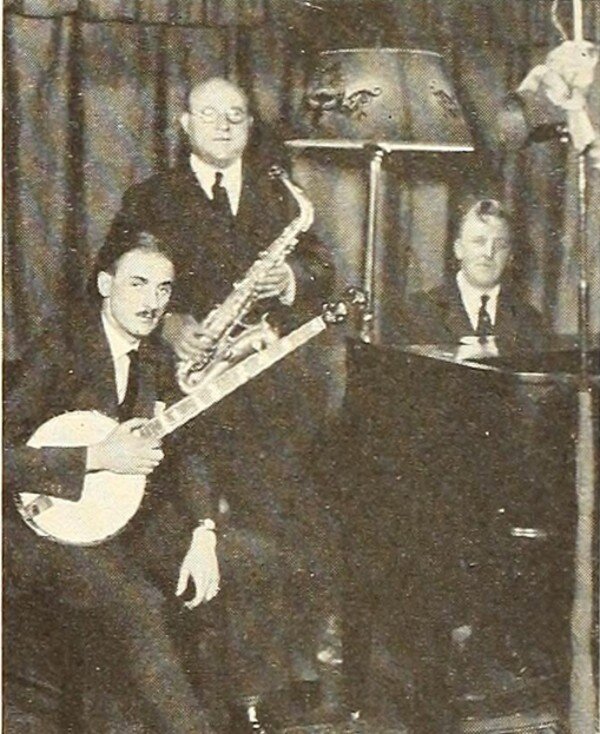When researching, oftentimes what we don’t know about someone can be more interesting than what we do know. In this situation, it can allow our minds to run wild, and allow us to think about history in different ways. In a previous piece in this column, there was a detailed write-up on Justin Ring, and since the issue of this piece, his story still remains mysterious but equally, if not more, tantalizing.
A majority of what there is to know about Justin Ring was saved within the pages of Fred W. Hager’s scrapbook and remaining papers. Hager kept a scrapbook between 1898 and 1907 or so, but many pages are missing in its current state. A good portion of the information on Ring is derived from a single page in his scrapbook, detailing his musical upbringing and simple information like his birthdate. This page mentions Justin’s father, a prominent arranger for orchestras and military bands in the middle to late 19th century, even beyond that time Justin’s father remains a looming character in this story.
Justus Ringleben, Sr., was born in Prussia in 1826, it is unknown when exactly he moved to the United States, but it was likely in the late 1840s or early ’50s. His past before “settling down” on the Bowery is unknown, but one can wonder if he married and had a family before that which produced Justus Jr. Public records in this era are a mixed bag, sometimes they exist, other times they don’t, so finding any definitive records of Justus Sr. before 1880 has proven difficult.

Justus Jr. was born in June of 1876, and to add to the mystery, it is unknown who Jr.’s mother was. A second son, Franz, was born in 1878, and according to the family, the identity of his mother is also unknown. The biological mothers of the boys may or may not have been the same women, but it is certain that the woman whom Justus Sr. married, Rosina, was not the boys’ mother. With this chaotic environment around him already, little Justus was often forced to fend for himself on the Bowery and lower east side, the roughest and most crowded area of New York in the latter 19th century. Their family flat was a few blocks from the Bowery and the infamous tenements.
Even with careful studying and reading between lines, little to nothing can be deciphered of Justus’ personality, but one thing is for sure—he was quiet. The stereotypes of Bowery kids in this era did not seem to align with the reserved and gentle demeanor that can be ascertained of Justus. His father encouraged all three of his children into music, and found such hope and promise in Jr. he sent him to work with the concertmaster to Anton Seidl, a Hungarian conductor who became leader of the New York Philharmonic in 1892. Justus was on his way to becoming a great music man, being an obedient young student and servant to some of the most distinguished musicians in the United States at the time. There are a number of ways he could have first become associated with the phonograph folks.
It is unknown how he entered in the exclusive community of phonograph workers, but his musical connections are a good possibility. Ring started working for the newly formed Zon-O-phone company in 1899 when they started making their own masters. He also got into the clique-ish community of the Columbia phonograph company around the same time. It was also around 1899 that Ring met the greatest companion he ever had, Fred Hager. It is possible they may have met earlier, considering that both of them were connected with the New York Philharmonic, but in keeping with the theme here, this is unknown.

The two were immediately taken with one another, finding there to be an oddly perfect match for each other’s difficult sense of rhythm and tolerant nature. The two of them made outstanding violin solo records for the Zon-O-Phone in 1899 and 1900, producing what some have called the finest recordings of the pair of instruments of the brown wax era, these further proved their remarkable chemistry.
This great chemistry early on can spark curiosity within the circumstances of their relationship. While there’s no way to know for sure what their relationship was like, but one thing is for sure, they kept splitting up but ultimately getting back together.
They first started to enjoy each other’s company in 1901, joining the Masons on the same day, and in the next year, Hager attempted to live with Ring for a few months while they published a handful of songs together. They split up in 1905, and reunited around 1916 with the same sort of spark that brought them together in the first place. They split for brief periods between 1923 and 1947, but for the entirety of their lives, they remained very close friends. So close in fact, that even in their local papers in 1936 they were always mentioned together. Hager fondly called his old partner “Justy.”
Aside from his close relationship with Hager, he was the most valued lab worker in the early 1900s, with each record company using his arrangements and musical choices. His praise and talents were revered in the record labs and within the serious musical community in general. Despite these high praises, he was never really spoken of in terms of his personality and demeanor. From the few pictures of him, his body language is awkward and shy, often with downcast eyes or looking away, and very rarely smiling (genuinely).

Again, it is almost impossible to know what Ring was like, and this may actually be partially his own doing. All the record folks from Charles Prince to Clarence Williams and Perry Bradford spoke of Ring, but in a very minimal and insignificant way. Any mention of him in modern recording literature is just the same, minimal. He was likely just unimpressive. By the time James P. Johnson and Fats Waller would have seen him, he was a middle aged flaxen headed sound man, quiet and studious.
The book Bix: Man and Legend outlines in particular detail the Jean Goldkette orchestra’s dealings with eccentric engineer Eddie King, a recorder who worked very closely with Ring long before the late 1920s, and was still doing so at that time. It is certain that the Paul Whiteman musicians knew and dealt with Ring at the same sessions where King is roasted, but he is simply not mentioned anywhere. King was loud and aggressive, even into his old age, so that marked him well in the history books—but not Ring. Ring’s guarded and industrious character is likely what makes him so unknown, and he became ever more silent as he aged.
Ring retired in 1947, after a career that started around 1890. In his retirement, he wanted to forget about the past. A good example of this lies in the 1930 census, where he lied about his first marriage, by saying that he married first in 1909, but a marriage record from 1903 exists, proving he was married before the listed year. Young researchers like Jim Walsh were anxious to get information out of him, and wrote him some notes. It is unknown whether or not Ring wrote back to these letters, but considering his guarded ideas about his recording past, he probably didn’t.

Hager was approached by Walsh at that time, and he was awfully excited to get Walsh’s letters, writing back to every single one in great detail. With someone like Ring who was so quiet about his past, the unknowns of his life can get us wondering. It is often the quiet, studious ones that are the most interesting in the field of research; they haven’t much to say but the silence speaks volumes.
R. S. Baker has appeared at several Ragtime festivals as a pianist and lecturer. Her particular interest lies in the brown wax cylinder era of the recording industry, and in the study of the earliest studio pianists, such as Fred Hylands, Frank P. Banta, and Frederick W. Hager.






















